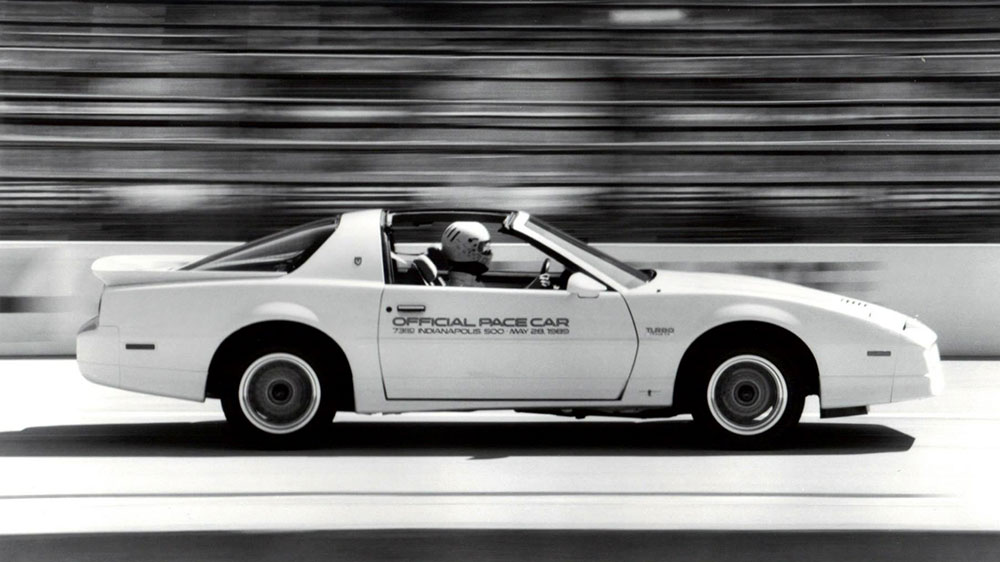
The 1989 Pontiac Turbo Trans Am marks the end of the Turbo Buick era. GM’s last installation of the turbocharged and intercooled 3.8 liter V6. The same engine that powered the legendary 1987 Buick Grand National GNX. Finally installed in a platform that made sense. A car that came complete with all of the braking and handling upgrades available.
And selected as the pace car at Indy. I know what you are thinking. But in 1989 the only modification made to the Turbo Trans Am to pace the actual race was the addition of lights. This one didn’t need any other modifications. It’s fast, handles, and stops.
This posts features a review from Car & Driver, this history of the Turbo Trans Am, several photo galleries, and a video of the 1989 Indy 500 that includes scenes of the pace car.
There are several Dean’s Garage posts that feature Buick’s Turbo V6. Check them out.
20th Anniversary Pontiac Trans Am
by Csaba Csere
Car & Driver Magazine, June 1989
Gentlemen, Light Your Tires
When the intercooled version of Buick’s turbocharged Regal T-type hit the streets in 1986, we suddenly found ourselves in the strange position of being captivated by an obsolete mid-sized sedan. Old and crude, the potent T-type was nonetheless irresistible. Here was a car costing barely $15,000 that could run 0-60 mph in just 4.9 seconds. A later version, the GNX, was quicker still. Judging by the bidding frenzy that arose when the 500-unit run of GNXs went on sale, we weren’t the only ones seduced by Buick’s old-fashioned, big-horsepower performance.
Much as we enjoyed the Regals, however, we couldn’t help but wonder how the mighty Buick V6 turbo would feel in a modern, sophisticated car- a car with the taut handling and sleek aerodynamics to exploit the engine’s heroic output fully. Why not the Pontiac Trans Am? We wondered. Here was a car within the General Motors corporate umbrella that was not only considerably more contemporary than the Regal but that also needed some mechanical differentiation from its Chevrolet Camaro sibling. GM was apparently thinking the same thing, for now the Buick-turbo-engined Trans Am is a reality.
To celebrate the twentieth anniversary of its muscle car, Pontiac is producing a run of 1500 special Trans Ams powered by a modified version of the lusty Buick Turbo 3.8L V6. This limited production 20th Anniversary Trans Am has also been selected as the pace car for this year’s Indianapolis 500. Like the Corvette convertible that paced the 1986 race, the turbo-T/A pace car will be completely stock – except that it won’t have air conditioning and will wear special lighting equipment
Of course, the hoopla surrounding this car would be hollow indeed if the 20th Anniversary Trans Am wouldn’t outperform the old Regals. Rest assured that the turbo-T/A is equal to the accolades…..
Our test car scorched the drag strip with a 0-60-mph blast of 4.6 seconds and a quarter-mile run of 13.4 seconds at 101 mph. That means, as we go to press that the turbocharged Trans Am is the quickest 0-60 sprinter available in any US production-car showroom – at any price.
Achieving such stunning times doesn’t require high-rpm clutch drops or other test-track trickery. Just pop the automatic transmission into Drive, hold it with the brake while you raise the engine speed to 2100 rpm, release the brake, and floor the throttle. The turbo Trans Am instantly shoots forward like a runaway rocket sled. The roar from the under the hood builds as the boost gauge needle dances around the 16.5-psi mark. And the Turbo Hydramatic T200R4 four-speed automatic snaps off crisply at just over 5000 rpm – without a nanosecond of lost thrust. The rush is so strong that the turbo Trans Am reaches 130 mph in just 30.2 seconds.
You’ll recall that Buick engineers calibrated the engine control computers in the turbo Regals to douse the fires under the hood at 124 mph. The speed cutoff was necessary to keep the old Regals within their modest handling and braking limits. No such precautions are needed with the turbo Trans Am. Thanks to its performance-oriented platform, the turbo T/A can run without a speed limiter. Thus freed, the turbocharged 3.8-liter V6 is able to push the Trans Am all the way up to 153 mph. At last: straight-line performance that delivers on the promise of both the Trans Am and the Buick V6.
The engine providing the motivation for these fireworks is basically the same turbo V6 used in Buick’s Regals. The most significant change is a new set of cylinder heads, borrowed from the transverse-mounted version of the 3.8-liter six that GM uses in many of its front-drive cars. Pontiac adopted the new heads because they fit more easily within the narrow confines of the Trans Am’s engine compartment. In addition, the new heads provide better exhaust flow and have a more efficient combustion-chamber shape than their predecessors.
A new set of pistons match the cavities in the new heads to preserve the engine’s 8.0:1 compression ratio. The exhaust gases are collected from each cylinder head via short-runner, equal-length headers and are fed to an AiResearch T3 turbocharger mounted in the right-front corner of the engine compartment. The turbo blows through an intercooler mounted just behind the radiator to pressurize a tuned intake system fitted with sequential fuel injection. A knock sensor reduces the chance of engine meltdown by signaling the engine-management system to retard spark advance and reduce boost pressure whenever it senses uncontrolled combustion. (To minimize these power-reducing measures, Pontiac recommends premium fuel.)
Pontiac’s output claims for the V6 are exceedingly modest: 250 hp at 4400 rpm and 340 pound-feet of torque at 2800 rpm. Judging by our performance figures, we estimate that the engine produces closer to 300 hp.
Bigger front brakes are the only other important mechanical change on the 20th Anniversary Trans Am. Beefy 11.9-inch-diameter rotors with twin-piston calipers replace the 10.5-inch rotors and single-piston calipers used on all other Firebirds. The big brakes provide the additional fade resistance needed to cope with the turbo’s penchant for high speed. Unfortunately, front-rear brake balance is poor. Out test car needed 217 feet to stop from 70 mph, largely because the rear discs locked up prematurely. Pedal feel was also disappointing.
The 20th Anniversary Trans Am shares its other underpinnings with the GTA and Formula Firebirds. For the suspension, that means struts in front, a precisely located live axle in the rear, and deflected-disc, gas-filled shocks and stiff coil springs at all four corners. A 36mm anti-roll bar is used up front; a 24mm bar is fitted to the rear. Traction is provided by P245/50ZR16 Goodyear Gatorbacks on 8.0-inch-wide aluminum wheels. The only non-standard suspension parts are slightly softer front springs, which are suitable because the blown V6 weighs about 100 pounds less than the V8 engines normally fitted to Trans Ams.
The turbo T/A’s suspension works superbly on smooth surfaces. The car steers precisely and adheres to the road with a vein-popping 0.88g of grip. Best of all, the T/A is wonderfully stable at the limit – although the engine’s surgy power delivery can make fine adjustments difficult. There’s just enough understeer to instill confidence, but you can easily kick the tail out by flicking the wheel or stepping into the boost.
Unfortunately, the turbo Trans Am loses its manners when the road gets rough. There seems to be a mismatch between the springs and the shock absorbers – a mismatch that keeps the Trans Am from ever settling down and feeling planted. Big bumps bottom the rear suspension easily – causing the car to bounce and lose traction when you’re cornering hard.
Small bumps can be almost as irritating. Tar strips and misaligned pavement slabs pound through the suspension so brutally that you’d swear the tires were made of solid rubber. Fender clearance is also on the tight side; both the front and rear tires occasionally rub against the bodywork in normal driving. All in all, the old turbocharged Regals were infinitely more comfortable for relaxed cruising.
The nonabsorbent ride would be less bothersome if the anniversary Trans Am were tight and solid. But every bump summons another in a seemingly endless repertoire of creaks, groans, squeaks, and rattles. Admittedly, our test car was at a disadvantage – being equipped with the optional T-top removable roof panels – but even solid-roofed Firebirds suffer from this unbuttoned feeling. All 20th Anniversary Trans Ams are being built in a special production facility, where an additional quality-control stage attempts to tighten up the car as much as possible. But there’s only so much that can be done with the Firebird’s basic structure.
If you’re beginning to get the idea that the turbo Trans Am has more in common with a 1965 GTO than with a modern sports car, you’re right. The T/As remarkable acceleration and amazing handling comes more from brute muscle and huge, sticky tires than from finesse and refined technology. The 20th Anniversary Trans Am is a muscle car from the traditional mold.
Inside, the turbo T/A displays a mixture of modern and old. The basic combination of a big exterior and a small interior harks back to the inefficient days of yesteryear, while the instrument layout, the modern seats, and the excellent driving position seem fully up-to-date.
Included as standard equipment is a set of futuristic-looking sport seats, which offer power lumber and side-bolster adjustments – as well as manual controls for headrest position, thigh supports, and front height. Equally contemporary are the radio controls in the steering wheel hub, which work well without interfering with your hand positions on the wheel.
All 20th Anniversary Trans Ams come in white with tan interiors. Further identification is provided by “Turbo Trans Am” badges on both front fenders, Indianapolis logos on both rocker panels, cloisonné “20th Anniversary Trans Am” insignias on the nose and both C-pillars, a new filler panel between the taillights, and quad tailpipes. In addition, each car comes with a set of “Official Pace Car” decals that the owner can mount on the doors, if desired.
Clearly, the 20th Anniversary Trans Am is not for fans of delicate, high-winding automotive works of art. This is a car for muscle-car mavens, pure and simple. And that’s not such a bad thing, because those old enough to have had firsthand experience with the muscle cars of yore are likely to be the only ones who have the $31,198 needed to acquire a 20th Anniversary T/A. That’s about $9,000 more than a comparably equipped Trans Am GTA with the 5.7-liter V8.
Many of you may find that a ridiculous sum for what is essentially an engine option and some added logos. And we tend to agree. But there seem to be plenty of buyers who are less concerned with refinement or cost than they are with pavement-wrinkling performance. Buick had absolutely no trouble selling all the GNXs it could build – mostly because they delivered old-time horsepower as few modern cars can.
We’re willing to bet that Pontiac won’t be holding any muscle car clearance sales, either.
Specifications (Car & Driver)
Vehicle Type: front-engine, rear-wheel-drive, 2 + 2 passenger, 3-door coupe
Price as tested:………. $31,198
Options on test car: base Pontiac 20th Anniversary Trans Am – $29,839, T-top roof – $920, freight – $439
Standard accessories: power steering, windows, and locks, A./C, cruise control, tilt steering, rear defroster
Sound system: Delco-GM AM/FM-stereo radio/cassette with graphic equalizer, 4 speakers
Engine
Type: turbocharged/intercooled V6, cast iron block and heads
Bore x stroke: 3.80 x 3.40 in. (96.5 x 86.4 mm)
Displacement: 3791 cc (236 cu in.)
Compression ratio: 8.0:1
Engine control system: GM electronic with port EFI
Valvetrain: OHV, 2 Valves/cylinder
Emissions control: 3-way catalytic converter, feedback fuel-air ratio control, EGR,
Turbocharger: AiResearch T3
Wastegate: Integral
Maximum boost pressure: 16.5 psi
Power (SAE net): 250 hp @ 4400 rpm
Torque (SAE net): 340 lb-ft @ 2800 rpm
Redline: 5250 rpm
Drivetrain
Transmission: 4-sp. automatic w/lockup converter
Transmission ratios: (1st) 2.74:1, (2nd) 1.57:1, (3rd) 1.00:1, (4th) 0.67:1
Axle ratio: 3.27:1, limited-slip
Dimensions
Wheelbase: 101.0 in.
Track, f/r: 60.7/61.6 in.
Length: 191.6 in.
Width: 72.4 in.
Height: 50.0 in.
Frontal area: 21.1 sq. ft.
Ground clearance: 4.5 in.
Curb weight: 3468 lb
Weight distribution, f/r: 55.4/44.6%
Fuel capacity: 18.0 gal
Oil capacity: 6.4 qt.
Water capacity: 17.2 qt.
Trunk space: 5.8 (+ 9.1) cubic ft.
Chassis
Type: Unit construction w/ one rubber isolated crossmember
Body material: Welded steel stampings
Suspension
Front: Independent strut located by control arm, coil springs, anti-roll bar
Rear: Rigid axle located by 2 trailing links and torque arm, Panhard rod, coil springs, anti-roll bar
Steering
Type: Recirculating ball, power-assisted
Turns lock-to-lock: 2.3
Turning circle, curb-to-curb: 32.6 ft.
Brakes
Front: 11.9 x 1.0-in. vented discs
Rear: 11.7 x 0.8-in. vented discs
Power assist: Vacuum
Wheels
Wheel size: 8.0 x 16 in.
Wheel type: Cast aluminum
Tires: Goodyear Eagle ZR50, P245/50ZR-16 Test inflation pressures, F/R: 30/30 psi
Performance
0-30 mph: 1.7 sec.
0-40 mph: 2.5 sec.
0-50 mph: 3.4 sec.
0-60 mph: 4.6 sec.
0-70 mph: 6.1 sec.
0-80 mph: 7.9 sec.
0-90 mph: 10.2 sec.
0-100 mph: 13.0 sec.
0-110 mph: 17.1 sec.
0-120 mph: 22.3 sec.
0-130 mph: 30.2 sec.
Top gear passing time, 30-50 mph: 2.9 sec.
Top gear passing time, 50-70 mph: 3.6 sec.
Standing quarter-mile: 13.4 sec. @ 101 mph
Top speed: 153 mph
Brakes
70-0 mph @ impending lockup: 217 ft.
Handling
Roadholding, 300-ft-diameter skidpad: 0.88g
Understeer: Moderate
Fuel Economy
EPA city driving: 16 mpg
EPA highway driving: 24 mpg
C/D observed fuel economy: 13 mpg
Interior Sound Level
Idle: 57 dBA
Full-throttle acceleration: 82 dBA
70-mph cruising: 75 dBA
70-mph coasting: 74 dBA
History of the Turbo Trans Am
Production
Originally conceived by Bill Owen of Pontiac, the 20th Anniversary Turbo Trans Am project was outsourced to PAS, Inc., an engineering firm led by Jeff Beitzel. Beitzel and his team did most of the TTA development work. The V6 turbo engines were built by PAS at their 40,000 square foot City of Industry, CA plant. From there, they went to GM’s plant in Van Nuys, CA to be installed into GTAs on the F-Body assembly line. The cars were then shipped back to PAS for final assembly, testing, and quality control. Incidentally, the GTA chassis were selected at random, thus there is no correlation between VIN number and production sequence number. The actual number of cars to be produced had ranged from 500 to 2,500 until GM finally settled on 1,500. In all, a total of 1,555 Turbo TAs were manufactured.
Features and Options
The 20th Anniversary Turbo Trans Am was offered as a complete package. Each was white with saddle (tan) interior, with T-tops and leather interior the only available options. Although other TAs were available with a CD player, the Turbo TA was available only with a Delco ETR AM/FM cassette with graphic EQ and redundant steering wheel controls. Externally, the TTA closely resembles a GTA. The primary visual clues are Indy “Winged Tire” emblems on the ground effects panel just aft of the front wheel wells, and dual twin stainless-steel exhaust tips. Closer inspection reveals “Turbo” emblems on the front fenders, “20th Anniversary” emblems on the nose and B-pillar, and a “Turbo” insignia between the taillights. Inside, a turbo boost gauge is incorporated into the tachometer face, and there is a “20th Anniversary” logo on the leather map pocket.
Special Indy Pace Car stickers were supplied for the windshield and doors. The cars were delivered without the stickers attached. It was up to the individual owner to apply them if desired. Original Turbo TA owners were sent a special box containing the door and windshield stickers, a Turbo TA keychain, cassette tape, letter of congratulations and a leather owners manual cover. There is a unique owners manual supplement that came with the car. As with most GM vehicles, the Firebird service manual and TTA supplement can be ordered from Helm (publisher of GM service manuals).
Technical Highlights
What makes the 20th Anniversary Turbo TA so special is that it is a complete mechanical package, and not just some tape stripes. Starting with the engine, Pontiac borrowed Buick’s 3.8 liter (231cid) V6 turbo powerplant from the fabled 1986-87 Grand National. Some difference exist between the TTA motor and the GN version. Different heads were necessary in order to squeeze the motor between the strut towers. These heads, adapted from the transverse FWD version of the 3.8 liter motor, have the added benefit of improved exhaust flow and combustion chamber design. Subsequently, different pistons were required in order to maintain combustion chamber volume.
Other changes to the TTA motor are a cross-drilled crank, larger 12 fin/inch GNX-style intercooler in place of the GN’s 10 fin/inch design, specially-designed stainless-steel headers, higher-pressure Bosch 237 fuel pressure regulator, and a re-calibrated engine control module.
Mark Grable, writing in the March 1989 Motor Trend, noted the Turbo Trans Am’s “250 horses…seem much stronger than run-of-the-mill horses.” The reason is simple. Although Pontiac officially rated the engine at 250 HP, in reality it developed an honest 301 HP on the GM dyno.
The Turbo TA came with the rare 1LE racing brake package, which upgrades the front discs to 12 inch police rotors, Corvette twin piston aluminum calipers and semi-metallic pads. These brakes are virtually fade proof, and were installed to legalize the 1LE package for Firehawk endurance racing. The rear discs were also increased to 12 inches in 1989 and use Corvette single piston calipers. All of the brakes on the car are of a quick change design, and pads can actually be changed in 30 seconds.
The only mid-year change made to the Turbo TA during the entire production run was a redesigned turbo inlet tube. The redesigned plastic tube was more durable, and had a clamping rib on either end to keep the hoses attached more securely. Other production changes in 1989 affected the Turbo TA and F-bodies in general. As an example, in March 1989 GM switched from glass to Lexan T-tops in order to save weight. However, the Lexan tops had severe problems with scratching and cracking, and GM had to replace most of them under warranty. During the 1990 production run GM switched back to glass T-tops after having so many problems with the Lexan ones.
Indianapolis 500 Pace Car
The 20th Anniversary Turbo Trans Am had the honor of being selected as the Official Pace Car of the 73rd Indianapolis 500, held on May 28, 1989. The three cars which did pace car duty were the first in the history of the Indianapolis 500 to do so with no performance modifications whatsoever. The only changes to the car were the usual safety equipment required by Indianapolis Motor Speedway (including a five-point seat belt harness), pace car lighting, and television-related equipment.
Strobe lights were installed into the front fog lights, front turn signals, and side marker lights. An additional set of strobes was inserted into the space between the spoiler and decklid. The rear windows were changed to ones with no defogger grid, so the rear-facing ABC television camera would have a clear view of the track behind.
In addition to three pace cars, an additional 162 “Festival” TTAs were at Indy for VIP and parade duty. All of the cars at Indy, including the three pace cars, had T-tops and cloth interiors. Approximately one hundred festival cars were sold to GM employees at the fixed price of $25,854.83. It was not a raffle, an interested employee simply had to fill out a form indicating they wanted the car at that price. Price was non-negotiable, and there was no choice of car. These buyers received cars with anywhere from a few hundred to 7,000 miles on them.
As for the three pace cars, one now resides in the Indianapolis Motor Speedway Museum, another is in the Pontiac collection, and one was presented to race winner Emerson Fittipaldi. Emerson loves his Turbo TA, when asked about it he grinned “It’s a FAST car!”
Specs (Pontiac Motor Division)
Engine:
3.8L SFI V6 Intercooled Turbo rated 250 bhp @ 4400 rpm, 340 lb-ft torque @ 2800 rpm
Bore x stroke: 3.800 in. x 3.400 in.
Valves: 1.710 in. intake, 1.490 in. exhaust
Crankshaft: nodular iron with 4 cross-drilled main bearings and 6 counterweights
Rods: Cast Armasteel, 151mm long
Pistons: Special design, 8.0:1 cr, 46.4mm compression height
Maximum boost: 16.5 psi
Recommended fuel: pump octane of 91 or greater
Trans: 200-4R 4 speed automatic with lockup torque converter
Brakes: Power 4-wheel disc, dual piston aluminum calipers vented 12″ front, 11.7″ rear rotors
Chassis: front MacPherson strut; rear live axle, 3.27:1 Borg-Warner “Australian” limited slip with torque arm
Sway bars: 36mm front, 24mm rear
Wheelbase: 101.0″
Length: 191.6″
Width: 72.4″
Height: 50.0″
Track f/r: 60.7″/61.6″
Curb weight: 3346 lbs.
Weight dist, f/r: 57.0/43.0
Performance
0-60: 5.5 sec
1/4 mile: 13.5 sec
60-0: 139′
Roadholding: 0.86g
Weight/hp: 13.4:1

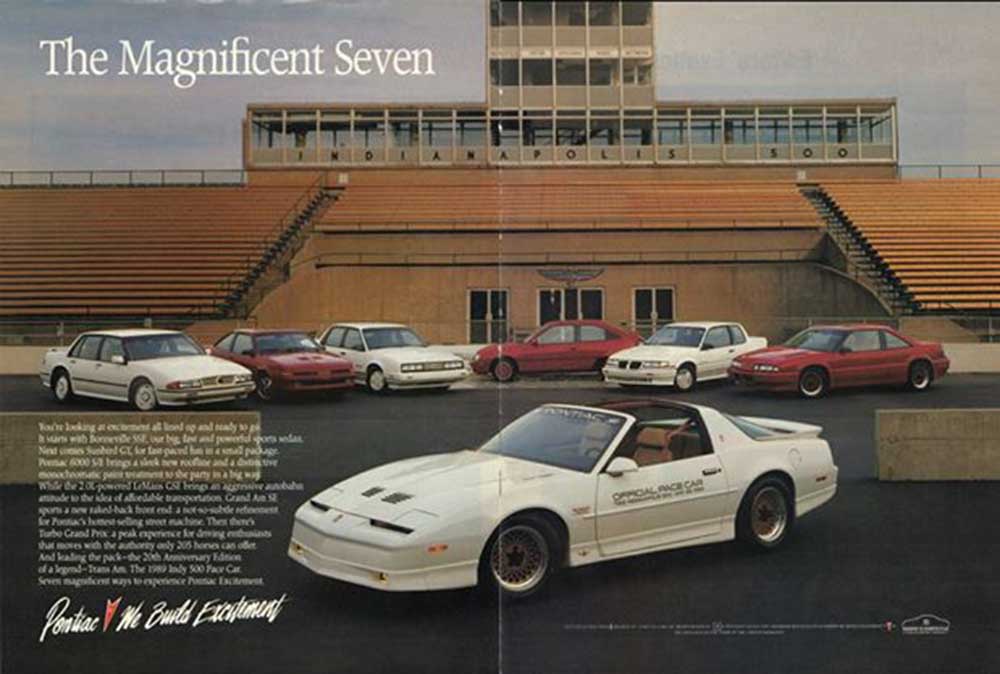
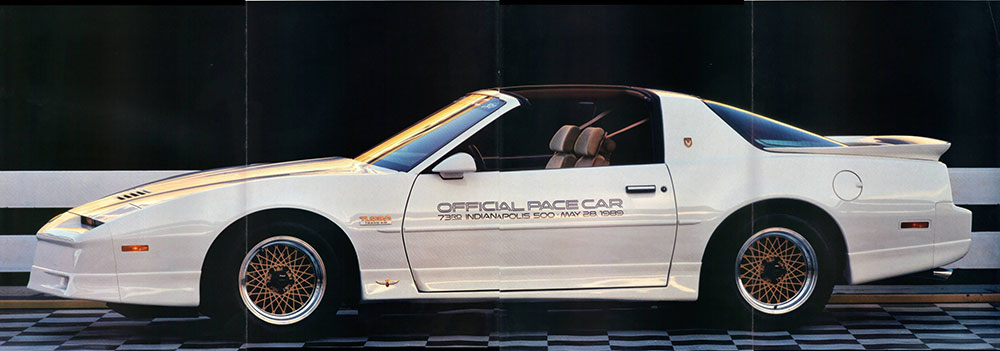
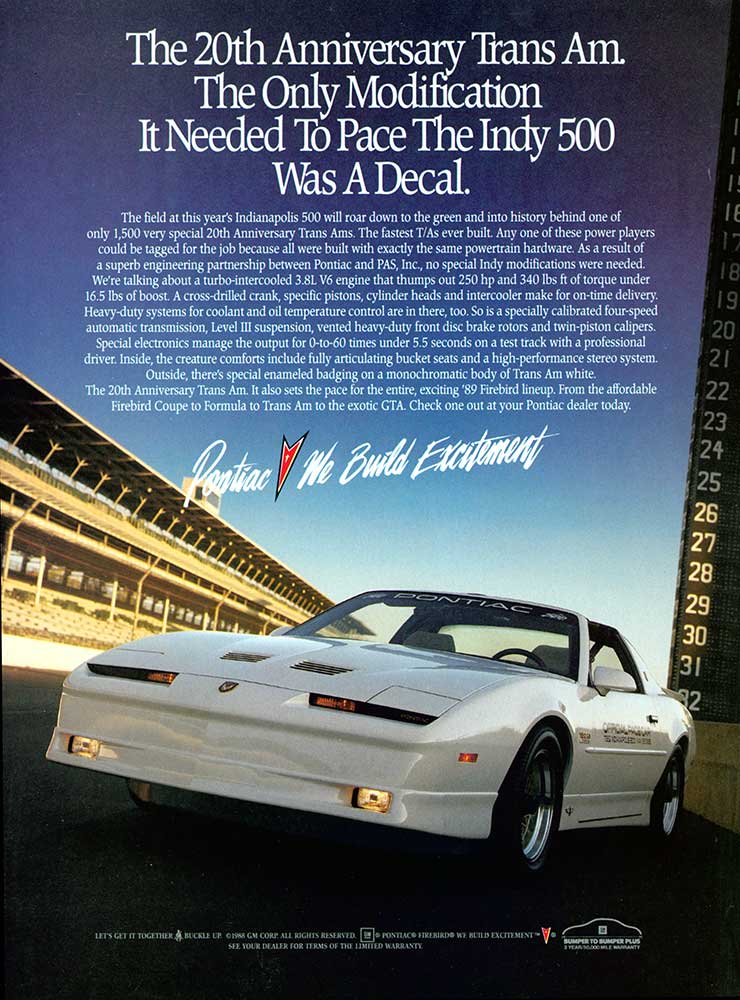
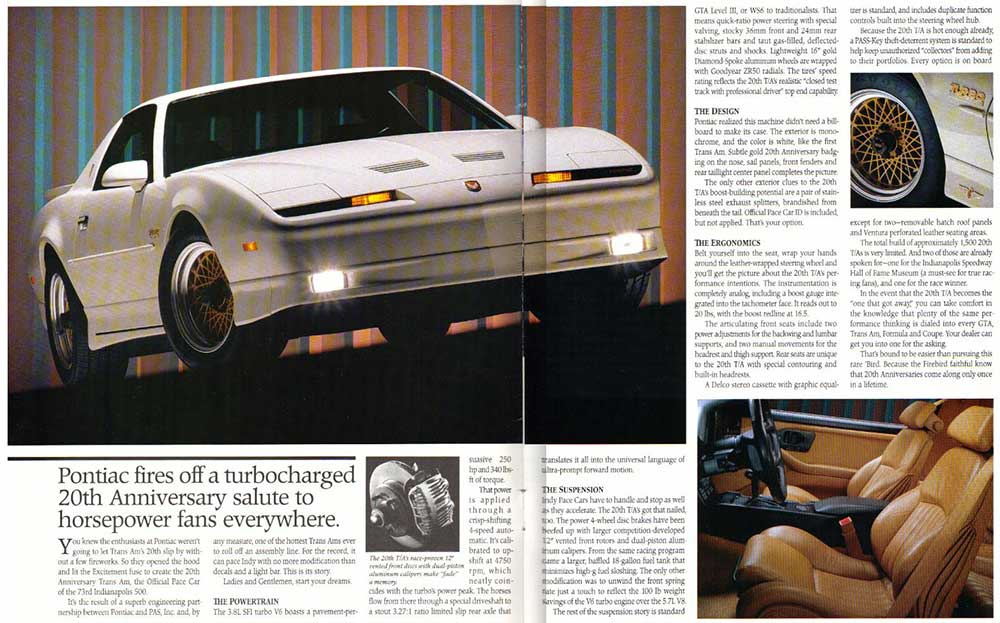
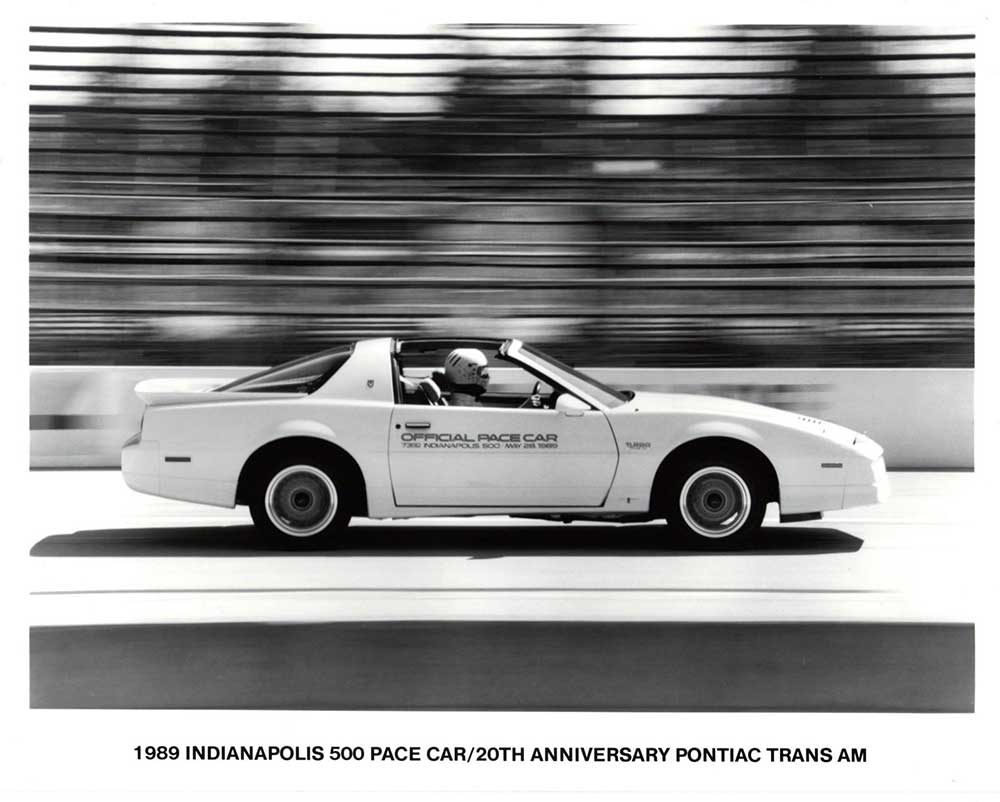
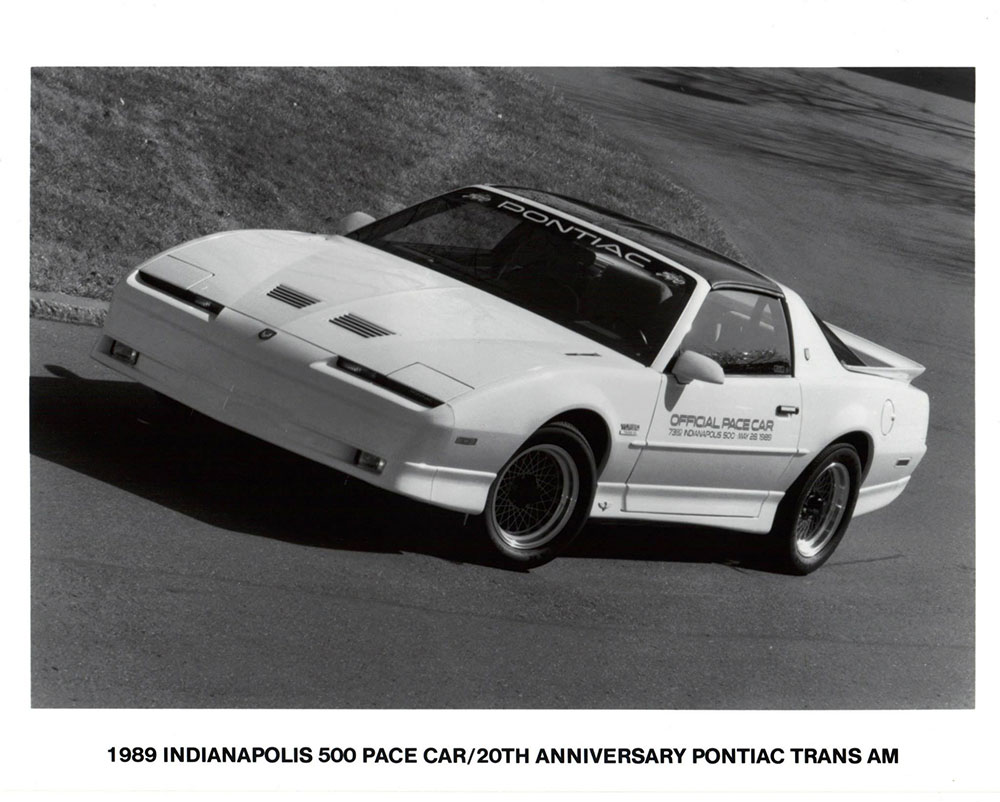
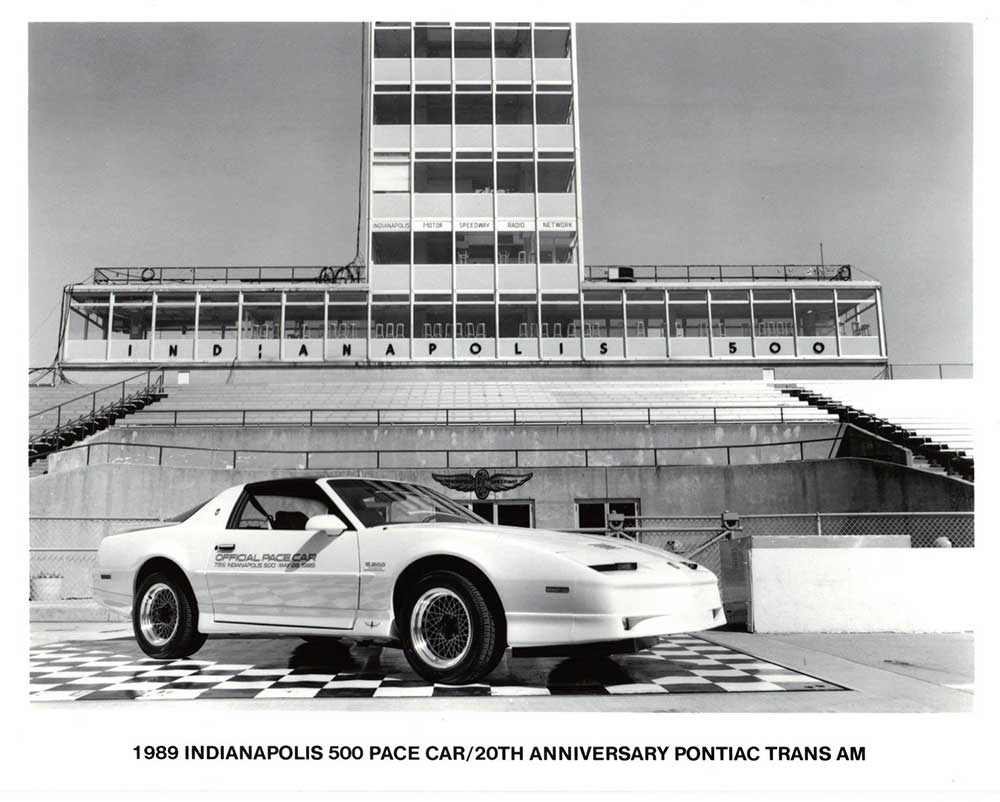
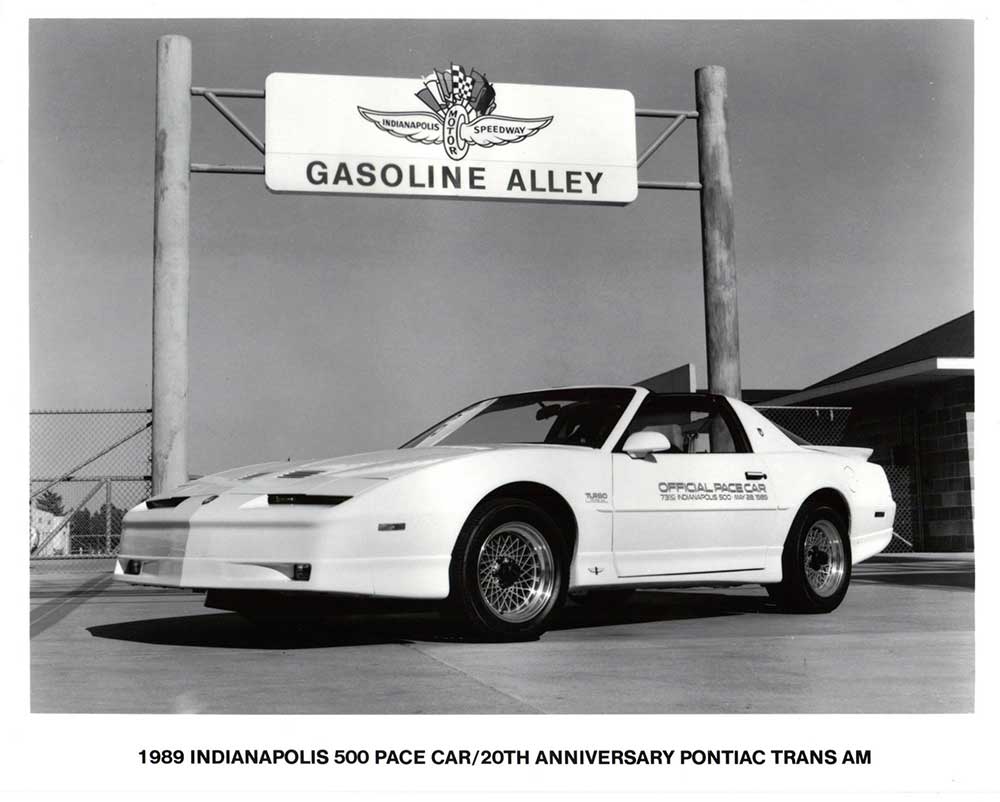
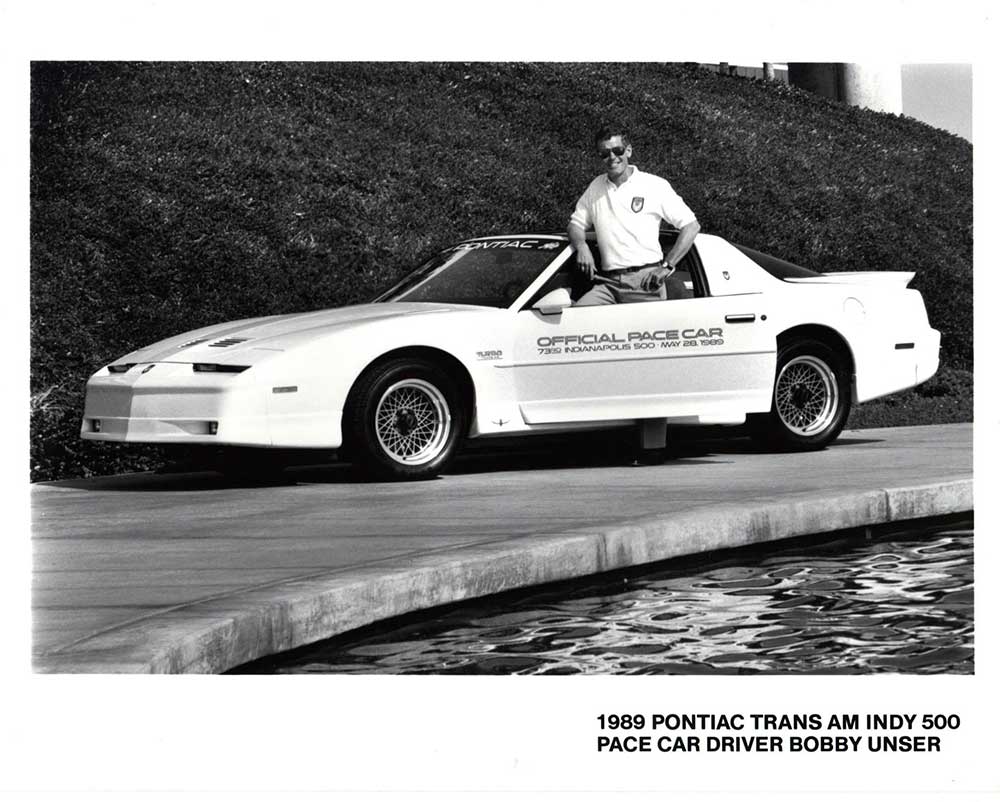
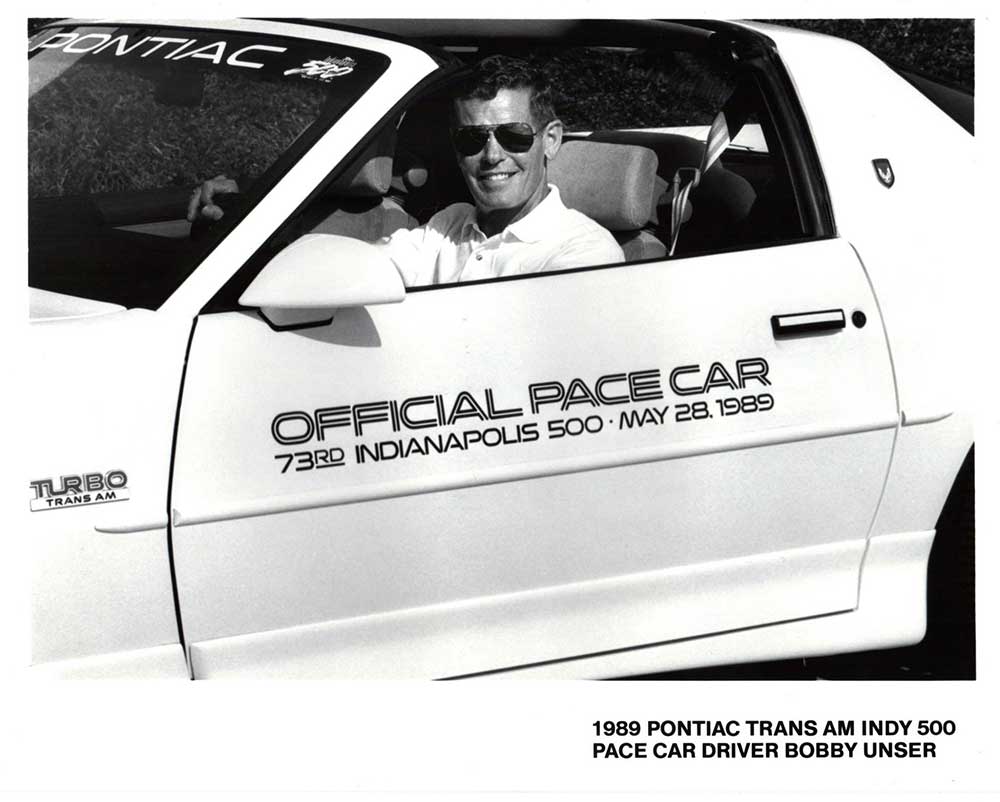
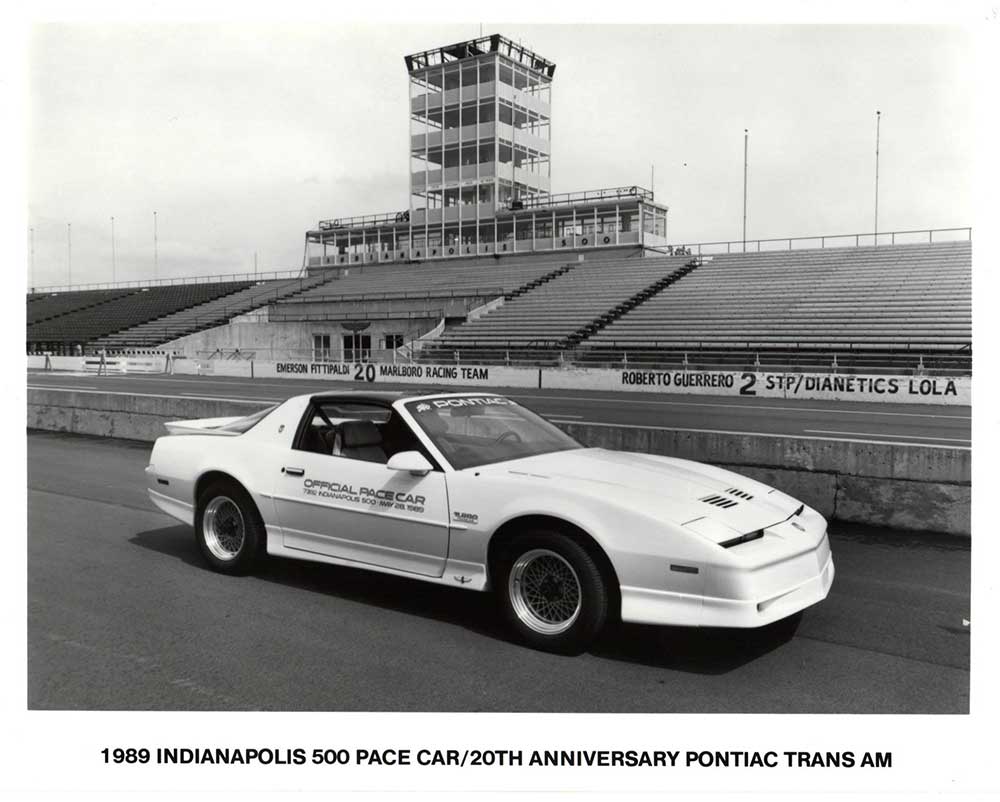
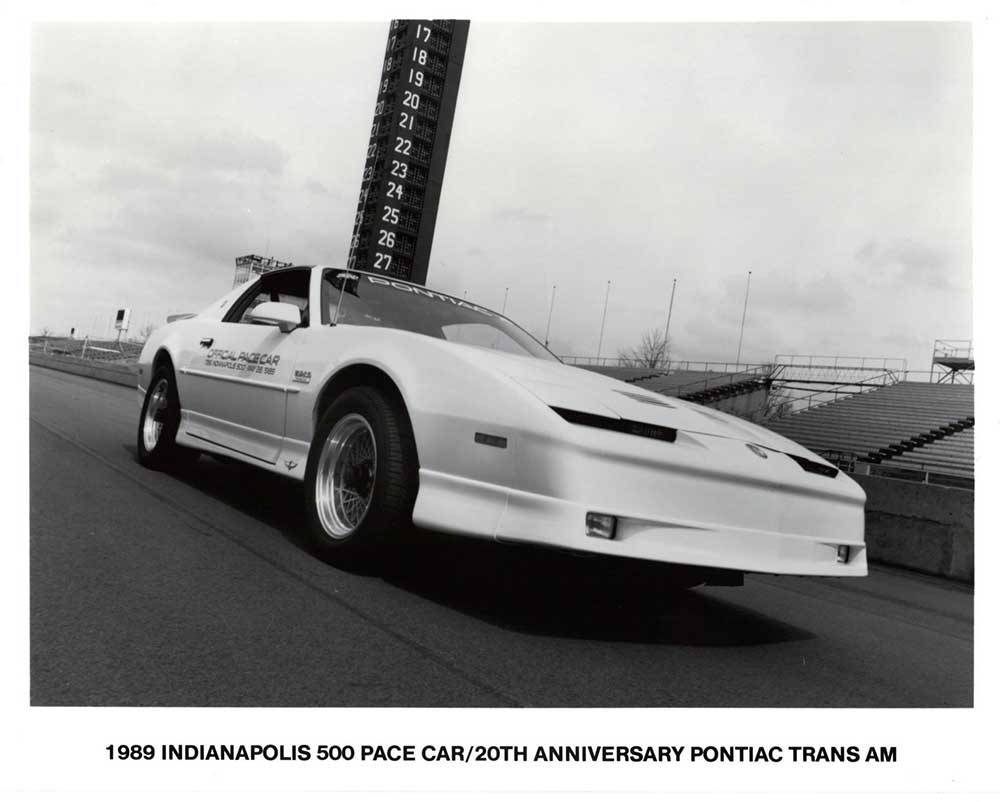
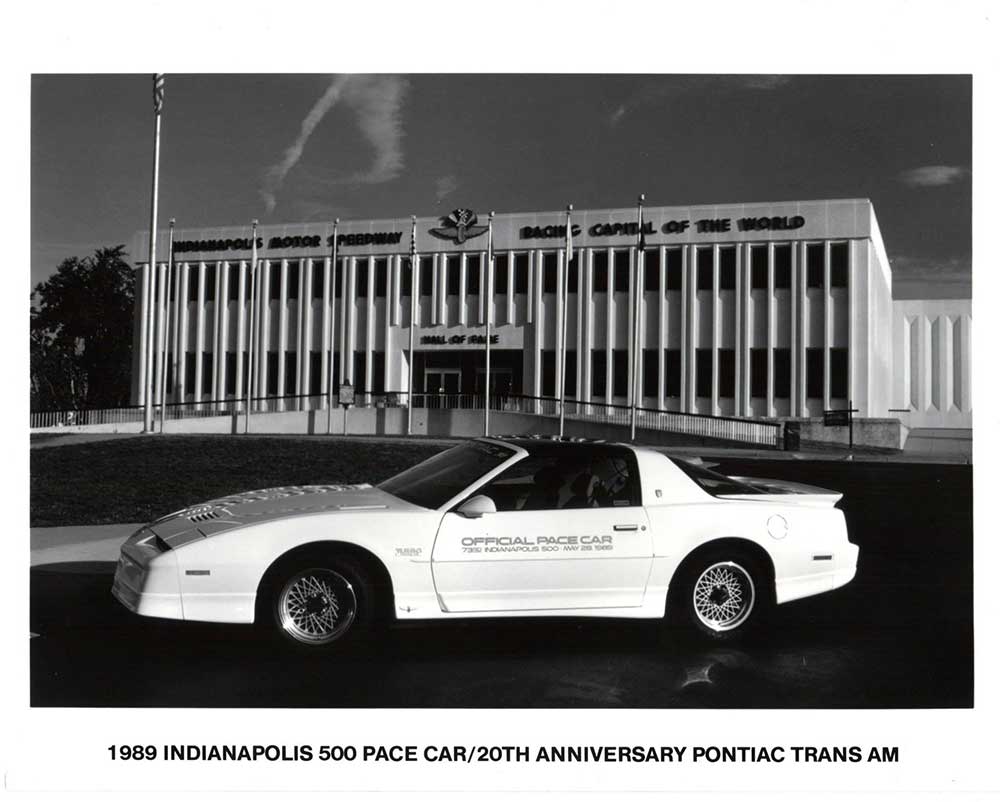
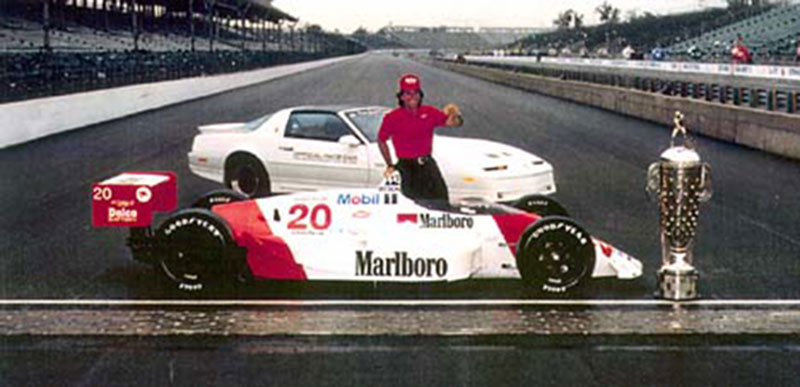

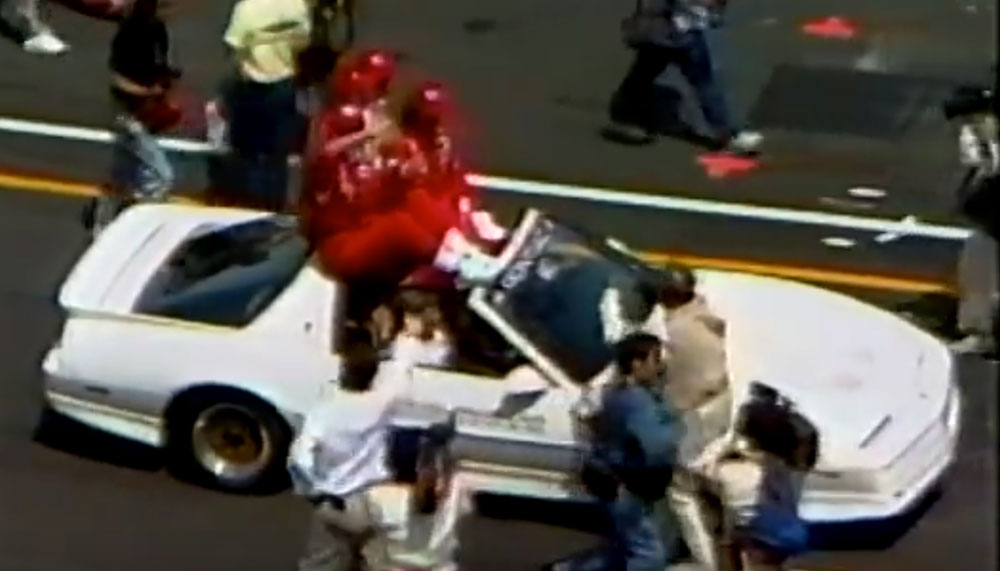
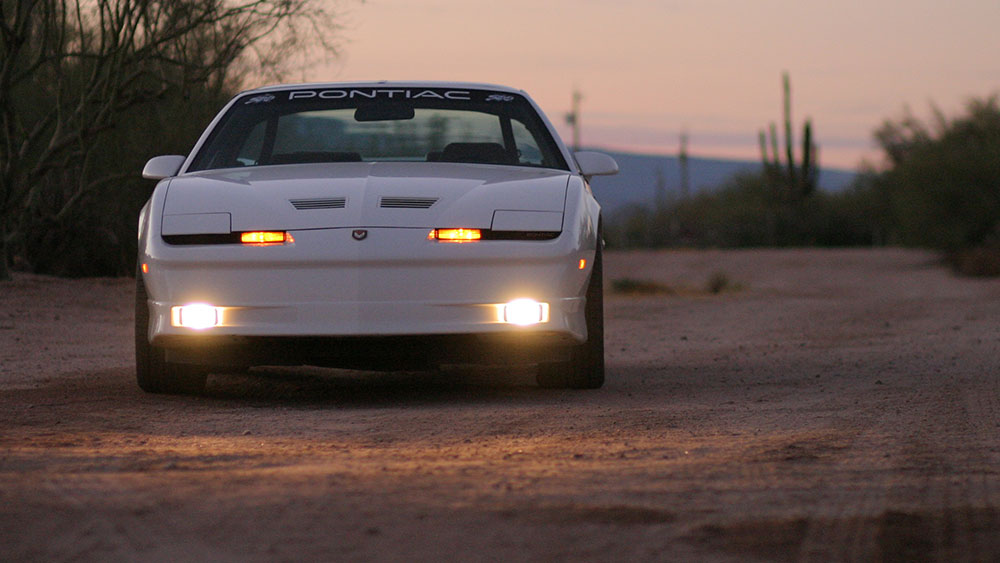












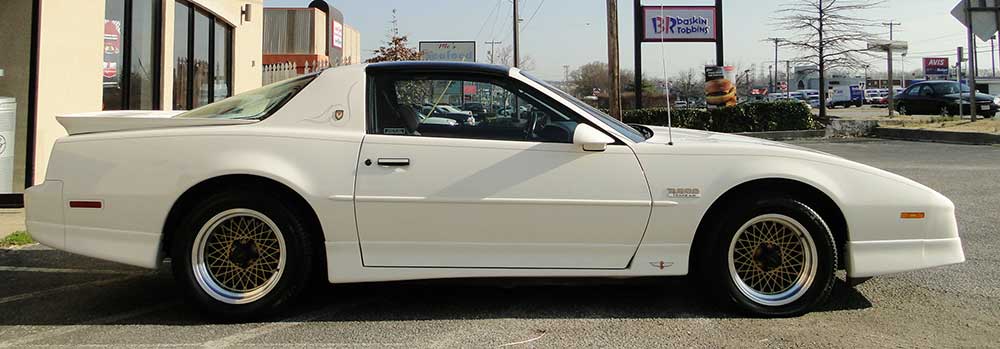
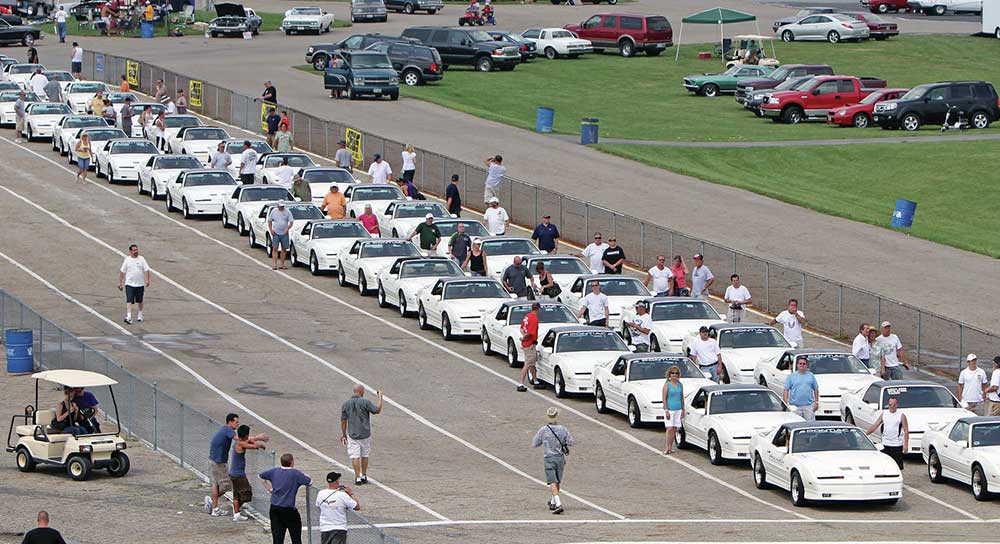
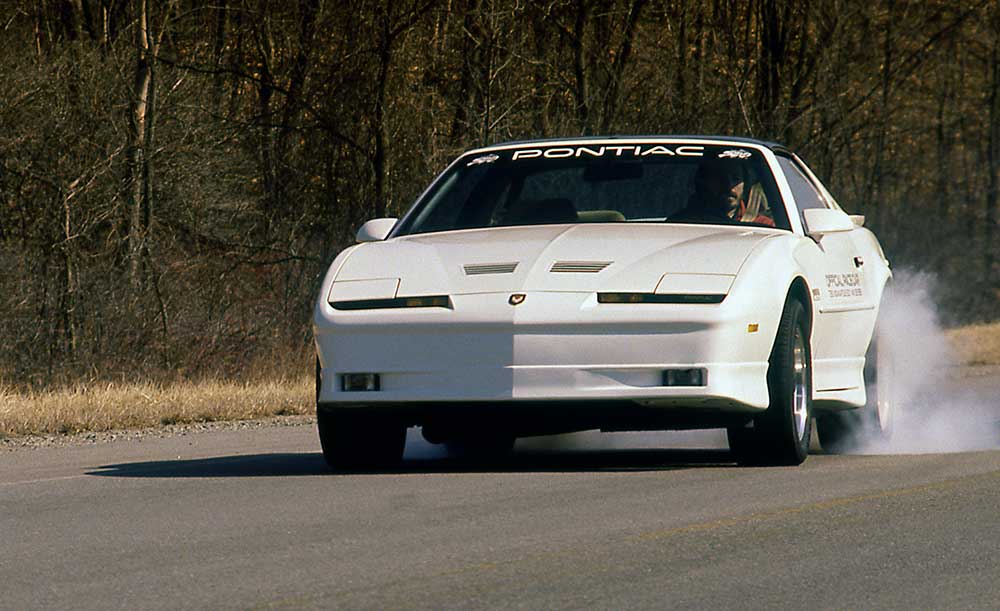
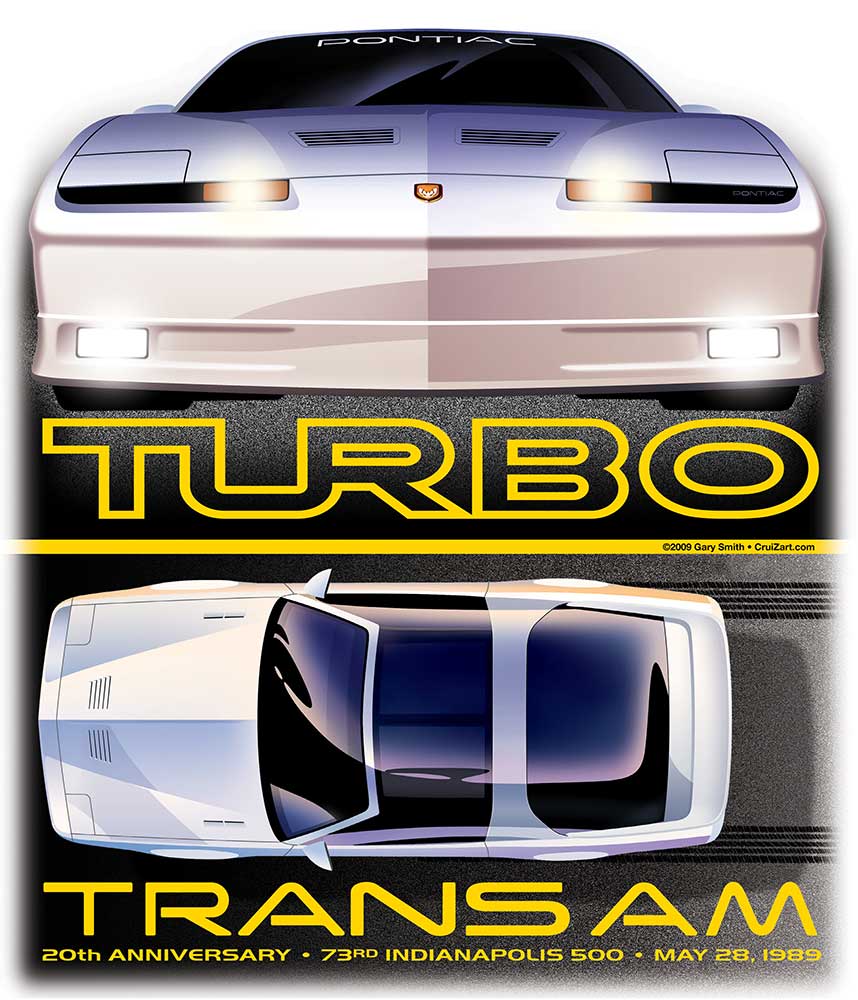
Have a 1989 Pontiac 20th Anniversary Trans Am Pace Car. Pulled the original engine (to preserve it for possible future restoration) and built a new modified engine from scratch. Had it dyno tuned last week. Now the turbo spools quicker and I’m really enjoying it.